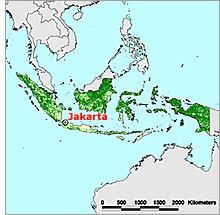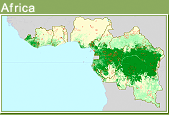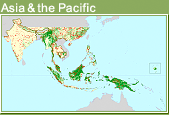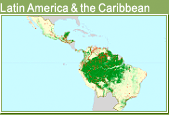Country details
Status of Tropical Forest Management 2005
Asia & the Pacific
Indonesia

©UNEP-WCMC 2004
Indonesia's forest resource base is still vast, but it faces many threats that put its long-term sustainability in jeopardy. These include illegal logging; forest fires; deforestation through land encroachment; wasteful logging and processing; structural deficiencies and inefficiencies in forest industries; the indebtedness of forestry enterprises; unsettled land claims; inefficiencies in public forest administration, in particular in the process of decentralization; an inadequate base of human resources; inadequate monitoring and evaluation; and a lack of effective governance. On the other hand, significant progress has been made in the establishment of certification systems and information on the management of concessions is becoming increasingly available.
Key points
- The estimated 68.5 million hectares of Indonesia's natural-forest PFE comprises 46.0 million hectares of production forest and 22.5 million hectares of protection forest. There are also about 2.50 million hectares of productive timber plantations.
- The security and integrity of the PFE are affected by several factors, of which forest fire and encroachment are among the most important.
- Illegal logging in the PFE (both production and protection) is widely held to be a major problem.
- The Ministry of Forestry is undertaking a review of concessions and their compliance with the Indonesian C&I. This process has shed light on the status of management in the production PFE.
- It is estimated that at least 2.94 million hectares of natural-forest production PFE and 1.36 million hectares of protection PFE are being managed sustainably.
- Some 12% of the land area of Indonesia has been designated as protected areas. However, information on the management of a large part of the protection PFE is scarce.
- Forestry is undergoing a process of decentralization that has proven difficult partly because of a lack of capacity at the decentralized levels of administration and partly because of disharmony in the policies of central and local governments.
- C&I for SFM have been developed for the country and a certification regime designed. About 275,000 hectares have so far been certified.
- The prescriptions for the management of production forests are conceptually sound but implementation has been weak. Over-capacity and structural imbalances in the wood-processing sector have exacerbated the situation.

 Africa
Africa  Asia & the Pacific
Asia & the Pacific  Latin America & the Caribbean
Latin America & the Caribbean